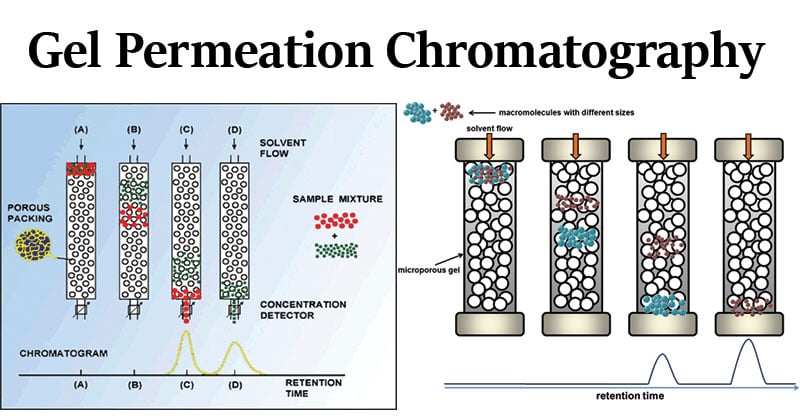Gel permeation chromatography is also called gel filtration or size exclusion chromatography.
In size exclusion chromatography, the stationary phase is a porous matrix made up of compounds like cross-linked polystyrene, cross-like dextrans, polyacrylamide gels, agarose gels, etc.
The separation is based on the analyte molecular sizes since the gel behaves like a molecular sieve.
This technique is used for the separation of proteins, polysaccharides, enzymes, and synthetic polymers.
As a technique, size exclusion chromatography was first developed in 1955 by Lathe and Ruthven.

Principle of Gel Permeation Chromatography
- It is a technique in which the separation of components is based on the difference in molecular weight or size.
- The stationary phase used is a porous polymer matrix whose pores are completely filled with the solvent to be used as the mobile phase.
- The molecules in the sample are pumped through specialized columns containing such microporous packing material (gel).
- The basis of the separation is that molecules above a certain size are totally excluded from the pores, while smaller molecules access the interior of the pores partly or wholly.
- The flow of the mobile phase hence will cause larger molecules to pass through the column unhindered, without penetrating the gel matrix, whereas smaller molecules will be retarded according to their penetration of the gel.
Components/ Instrumentation of Gel Permeation Chromatography
- Stationary Phase
- The Mobile Phase
- The Columns
- The Pump
- Detectors
A. Stationary phase
It is composed of semi-permeable, porous polymer gel beads with a well-defined range of pore sizes.
It has the following properties:
- Chemically inert
- Mechanically stable
- With ideal and homogeneous porous structure (wide pore size give low resolution).
- A uniform particle and pore size.
Examples of gel:
- Dextran (Sephadex) gel: An α 1-6-polymer of glucose natural gel
- Agarose gel: A 1,3 linked β-D-galactose and 1,4 linked 3,6-anhydro-α, L-galactose natural gel
- Acrylamide gel: A polymerized acrylamide, a synthetic gel
B. The Mobile Phase
It is composed of a liquid used to dissolve the bio-molecules to make the mobile phase permit high detection response and wet the packing surface.
C. Columns
Any of the following kinds may be used:
- Analytical column- 7.5–8mm diameters.
- Preparative columns-22–25mm
- Usual column lengths-25, 30, 50, and 60 cm.
- Narrow-bore columns- 2–3mm diameter have been introduced
D. Pumps
They are either syringe pumps or reciprocating pumps with a high constant flow rate.
E. Detectors
The detectors may be concentration-sensitive detectors, bulk property detectors, refractive index (RI) detectors, etc.
Steps in Gel Permeation Chromatography
It involves three major steps:
A. Preparation of column for gel filtration
It involves:
- Swelling of the gel
- Packing the column semi-permeable, porous polymer gel beads with a well-defined range of pore sizes.
- Washing: After packing, several column volumes of buffer solution is passed through the column to remove any air bubbles and to test the column homogeneity.
B. Loading the sample onto the column using a syringe
C. Eluting the sample and detection of components
Applications of Gel Permeation Chromatography
- Proteins fractionation
- Purification
- Molecular weight determination.
- Separation of sugar, proteins, peptides, rubbers, and others on the basis of their size.
- Can be used to determine the quaternary structure of purified proteins.
Advantages of Gel Permeation Chromatography
- Short analysis time.
- Well defined separation.
- Narrow bands and good sensitivity.
- There is no sample loss.
- The small amount of mobile phase required.
- The flow rate can be set.
Limitations of Gel Permeation Chromatography
- The limited number of peaks that can be resolved within the short time scale of the GPC run.
- Filtrations must be performed before using the instrument to prevent dust and other particulates from ruining the columns and interfering with the detectors.
- The molecular masses of most of the chains will be too close for the GPC separation to show anything more than broad peaks.








0 Comments